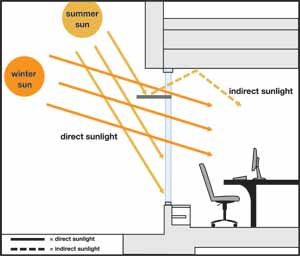Daylighting in Schools, Grades K-12
Architectural Features
Daylighting control principles have two major requirements: directing diffuse daylight delivery into interior spaces and the control of electric lighting output in response to the available daylight. An integrated approach must be conceived from the beginning of the project including building siting and orientation, window and/or skylight design, and lighting and shading control systems design, as well as ongoing maintenance. Daylight, electric lighting, and shading systems cannot be considered separately because daylighting affects electric lighting use and has the potential of introducing direct sunlight and glare that may be uncomfortable for building occupants. This requires cooperation between architects and lighting engineers. Daylight, electric lighting, controls and building design features must be seen as an integral part of the overall energy optimization program.
Building form and orientation can be designed to capture more daylight opportunities. The floor plan configuration should maximize the perimeter daylight zone. This may result in a building with a higher skin-to-volume ratio than a typical compact building design. Other examples of design elements used in effective daylighting include light shelves, glazing modulation, and light monitors. A standard window can produce useful illumination to a depth of about one and one-half times the height of the window. As a general rule-of-thumb, the higher the window is placed on the wall, the deeper the daylight penetration. With lightshelves or other reflector systems this can be increased to two times or more. A light shelf is a horizontal light-reflecting overhang placed above eye-level with a transom window placed above it. This design, which is most effective on southern orientations, improves daylight penetration, creates shading near the window, and helps reduce window glare. Exterior shelves are more effective shading devices than interior shelves. A combination of exterior and interior shading devices will work best in providing an even illumination gradient. Carefully select and detail glazing and location and design of window openings. Glazing specification depends on the exposure; Low E glazing with light transmission of 50 percent should be used on the vision panels with 68 percent or greater transmission on glazing above the light shelf. No light shelves or shading devices, and all 68 percent or greater light transmission glazing should be used on the north side.
|
||||||||||||||
Light monitors can follow an east-west axis to maximize exposure to the southern sun. Top-lighting provides interior light that is significantly different from that provided by windows: it can provide relatively uniform light distribution throughout a space, and it is often easy to integrate with electric lighting because light originates from the ceiling in both cases. Roof monitors can be designed to admit daylight and sunlight, although sunlight is difficult to control and best avoided; a roof aperture should be between four to eight percent of the floor area. Shape the roof monitor to admit only daylight from the north. Splaying walls and using matte white reflecting surfaces around the monitor improves light distribution and reduces glare. Using diffusing glass gives better distribution of light if a view of the sky is not critical. Horizontal skylights may result in excessive solar gains in summer. Brighter sky visible through skylights can also cause glare problems. In addition to maximizing the penetration of diffuse light, the building features must diffuse or block direct rays of the sun. Glare and overheating from the sun's direct rays inhibits the performance of visual tasks in classrooms, offices and other similar spaces. In order for spaces to be considered daylit, The USGBC LEED Standard requires that no direct sunlight be admitted to critical task areas.










